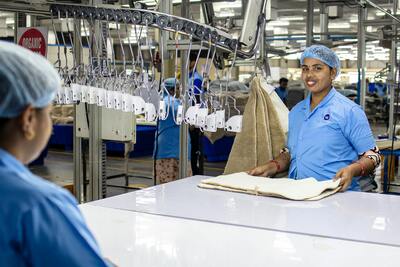Categories
Tags
-
#sporty swimwear
#swimwear wholesale
#swimwear manufacturers
#swimwear bulk
#bikini manufacturers
#bikini
#surfing
#one shoulder swimwear
#tankini manufacturers
#welonswimwear
#board shorts
#men fashion
#swimwear
#swimming
#kids swimwear
#rash guard
#swimwear factory
#SwimVest
#women swimwear
#swinwear facrics
#jaquard swimwear
#rashguard
#nintendo switch xbox
#custom swimwear
#men swimwear
#swim vest
#racing suit
#racing swimsuit fabrics
#monokini
Archives
The High-Tech Craft of Manufacturing Swimwear
-
Posted by Shelly Brown Filed in Other #sporty swimwear #swimwear wholesale #swimwear manufacturers #swimwear bulk #one shoulder swimwear #welonswimwear #swimwear factory #women swimwear 102 views
As swimwear manufacturers, we deal in precision. Creating a garment that needs to fit like a second skin, withstand chlorine and saltwater, and maintain its shape season after season is a unique engineering challenge. It's a blend of high-tech tools and specialized craft.
Many people are surprised by the complexity that goes into their favorite bikini or one-piece. It's not just about a great design; it's about the technical execution. Today, we're pulling back the curtain to focus on two of the most critical stages in our process: Pattern & Cutting and Stitching & Seam Construction.
1. The Digital Blueprint: Precision Pattern Making & Cutting
Before a single thread is sewn, the suit is "built" digitally. This foundational stage determines fit, comfort, and how efficiently we use our materials.
• From 2D Draft to 3D Avatar: Gone are the days of drafting every single pattern by hand on paper. Today, we use sophisticated Computer-Aided Design (CAD) software. Our pattern makers create a base pattern (e.g., a size Medium) and then digitally "grade" it to create a full-size range (XS to XXL). This isn't just scaling up and down; the software intelligently adjusts proportions for a consistent fit across all sizes.
• The Secret of "Negative Ease": Swimwear fabric is all about stretch. Unlike a cotton t-shirt, a swimsuit pattern must be smaller than the body it's intended for. This is called "negative ease." Our technical designers calculate the exact percentage of stretch in a fabric (fabrics with 4-way stretch are the standard) and engineer this negative ease into the pattern. This is why a swimsuit looks tiny on a hanger but stretches perfectly to hug your body without sagging when wet.
• Automated Spreading & Nesting: Once the patterns are finalized, they're sent to the cutting room. A machine called an automated spreader rolls out our fabric—which can be Lycra, nylon, or recycled polyester blends—into dozens, sometimes hundreds, of perfectly aligned, tension-free layers. Our software then runs a "nesting" algorithm. This arranges all the pattern pieces (fronts, backs, linings, straps) like a complex puzzle to ensure the absolute minimum amount of fabric is wasted.
• Laser-Sharp Cutting: While high-speed automated knives handle the bulk of the cutting, laser cutters are used for intricate designs or delicate materials. A laser provides a perfectly sealed, precise edge that won't fray, which is ideal for complex cut-outs or no-sew edges.
2. The Unseen Hero: Stitching & Seam Construction
A swimsuit is only as strong as its weakest seam. The stitches we use are designed for one primary purpose: maximum stretch and recovery. Using the wrong stitch would cause threads to pop the first time you wore the suit.
Here are the key stitches that make a suit durable:
• The Construction Workhorse (Four-Thread Overlock): Look at the main seam inside your swimsuit. You'll likely see two parallel lines of stitching on top and interconnected loops underneath. This is a four-thread overlock (or serger) stitch. It sews the seam, trims the raw edge, and finishes it all in one pass. Its interlocking loop structure allows it to stretch with the fabric, making it the go-to stitch for holding a suit together.
• The Elastic Expert (Three-Step Zigzag): Attaching elastic to leg openings, armholes, and waistbands is crucial for fit. We use a specialty stitch called a three-step zigzag. Instead of one stitch per "zig" and "zag," it takes three small, straight stitches in each direction. This distributes the stress and allows the elastic to stretch to its absolute maximum without breaking the thread.
• The Professional Finish (Coverstitch): This is the stitch you see on the hem of high-quality athletic wear. A coverstitch machine creates two or three parallel lines of straight stitching on the outside and a looper "ladder" stitch on the inside. We use it to create clean, flat, and stretchy hems, especially when folding elastic under.
• The Performance Seam (Flatlock): For performance-oriented or reversible suits, we often use a flatlock stitch. This seam joins two pieces of fabric edge-to-edge without any overlapping layers. The result is a completely flat, non-bulky seam that is incredibly strong and, most importantly, will not chafe—a must-have for active swimwear.
From a 3D model on a screen to the final coverstitch, every step is a deliberate choice. It's this hidden manufacturing technology that creates a garment you can rely on, allowing you to move, swim, and relax with total confidence.





